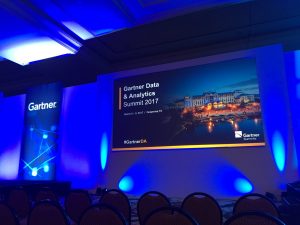 Earlier this month, I attended the Gartner Data & Analytics Summit in Dallas, Texas. The show featured more than 100 presentations in a variety of strategy, governance, and analytics topics over the course of 4.5 days.
Earlier this month, I attended the Gartner Data & Analytics Summit in Dallas, Texas. The show featured more than 100 presentations in a variety of strategy, governance, and analytics topics over the course of 4.5 days.
It is always interesting to get a pulse on where the business intelligence and analytics industry is headed and to see which topics resonate most with BI users. Here I’ll outline a few things that Gartner focused on during the event and what analytics users and organizations need to think about moving forward.
Information governance vs. self-service analytics
Gartner devoted an entire track in its conference to information governance, and with good reason. Organizations now have massive amounts of data and are allowing users of varying skill levels to analyze this data. Now they must figure out how to balance the risks and opportunity inherent in enabling users.
By 2018, 50% of business ethics violations will occur through improper use of big data analytics. #GartnerDA @ThomasOestreich
— Kathy Sucich (@ksucich) March 6, 2017
Trust in the data is critical as users analyze it. In order to achieve this trust and provide the right governance framework, as Gartner analyst Thomas Oestrich discussed in his presentations, organizations need to:
- Define their “rules of the game”
- Seek agreement across the organization
- Appoint data & analytics stewards
- Avoid over-governing
So how can organizations balance governance objectives with users’ desire for self-service analytics? Gartner analysts Rita Sallam and Mark Beyer had a great debate on this issue in one of the sessions. Sallam took the position of “chaos” while Beyer argued for “control” over data. Their ultimate recommendations came down somewhere in the middle:
- The top-down approach of governance is no longer viable. However, total freedom for users is very risky.
- Middle ground exists in balancing the two extremes of total governance vs. total freedom.
- One successful model is to teach users the rules of the road and digital literacy in exchange for access and crowd policing.
- Ultimately, you need to align your degree of control with your analytics hierarchy of needs and analytics maturity level.
Machine learning
In their opening keynote titled “Lead in the Age of Infinite Possibilities,” Debra Logan and Kurt Schlegel discussed how machine learning will impact the analytics industry. Their presentation highlighted “abundance” vs. “scarcity” – the abundance of data available vs. the scarcity of skills and ability to analyze to see true meaningful results.
As part of this presentation, Logan and Schlegel highlighted how machine learning will help organizations deal with a shortage of skilled staff by providing new insights. And, in typical Gartner fashion, there were many predictions included in the conference presentations. One of these, in the opening keynote, was that, “By 2019, 50% of analytics queries will be generated using search, natural-language query or voice, or will be auto-generated.” This prediction highlights that technology is becoming more sophisticated and the evolution of machine learning technology and integration into BI systems will provide new ways to gain insights.
Conference odds & ends
This year, I really enjoyed the keynotes by both Margaret Heffernan and Tim Harford. Heffernan is an entrepreneur, CEO, and author. She discussed how we all have mental models about how the world works, and how we need to challenge those models in order to make better decisions. A few words of wisdom from her keynote:
- Knowledge is only powerful when it comes to the right people at the right time and in the right way.
- One of the best uses of data is disconfirmation of our own mental models.
- As machines do more thinking, it becomes more imperative that we do more of our own thinking.
Harford, an author and columnist for the Financial Times, talked about how frustration makes us more creative. Harford told the story of Keith Jarrett, a jazz pianist who had to perform in Prague in 1975 on a broken piano. Despite the fact that he could not use half of the piano because the keys were broken or out of tune, what emerged from the concert was a masterpiece that ended up being the best-selling jazz solo album of all time.
#GartnerDA if you want to get somewhere new, start somewhere new says @TimHarford pic.twitter.com/t8jFCFUaQ5
— Rita Sallam (@rsallam) March 8, 2017
Harford contended that we often need to be frustrated or put into an uncomfortable position that we have to break free from in order to see new results. If you’d like to see a shortened version of his keynote for yourself, I found a TED Talk that Harford gave on the same subject.
Finally, I inevitably walk away from shows like this with a reading list of interesting books I need to check out. Two that caught my attention were:
- Abundance: The Future Is Better than You Think, by Peter Diamandis and Steven Kotler
- Longitude: The True Story of a Lone Genius Who Solved the Greatest Scientific Problem of His Time, by Dava Sobel
- Navigating the Future: Trends in Wine Tasting Rooms - July 16, 2024
- Why You’ll Want to Attend DIUC24 - June 20, 2024
- The Role of Technology in Solving Nursing Challenges - May 6, 2024


